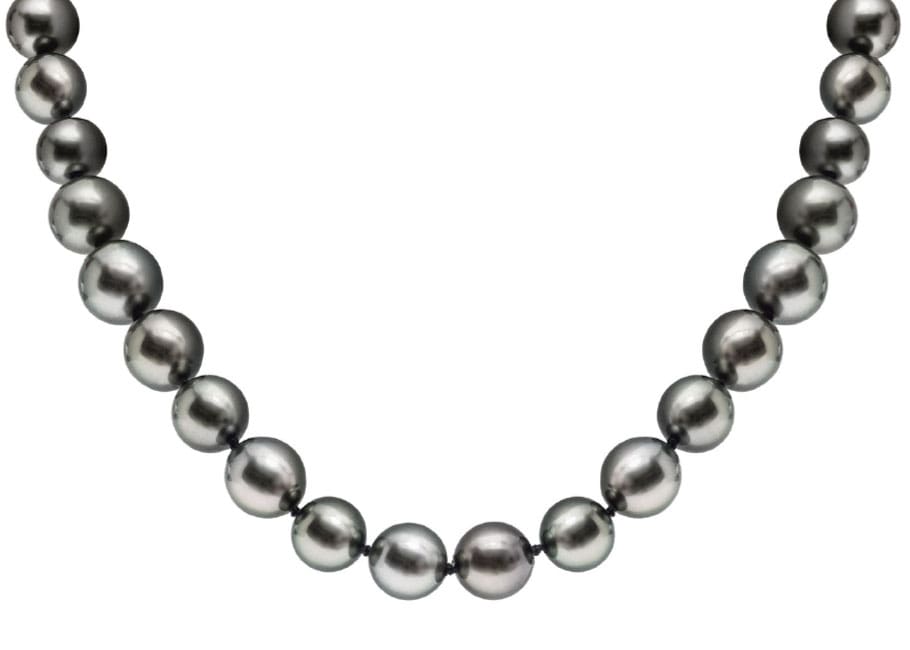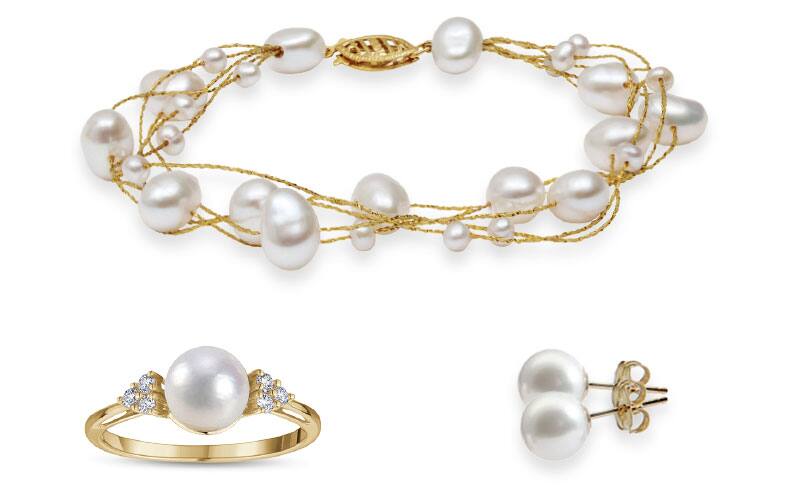INSIDE COSTCO // BUYING SMART

8–11 mm Cultured Tahitian Pearl Necklace (Item 499394)
Jewels of the sea
Lustrous and beautiful cultured pearls at Costco undergo a rigorous grading system to ensure quality
by LAURA BODE
Sometimes, in that mad dash to get groceries and other staples, it is easy to speed right by the true treasures at Costco: the jewels and precious metals on display in the jewellery case. My advice: Stop and marvel.
On a recent visit I did just that. One category that really stands out is Costco’s pearl selection. But shopping for pearls can be a bit confusing. What are the different types? What’s the difference between cultured and natural? Among other questions. Fortunately, I could turn to Julianna Nowaczek, Costco’s jewellery buyer, for answers.
“Pearls are definitely having a moment,” says Nowaczek. “They are going into engagement rings, and men are now wearing pearls.”
What is a pearl?
Pearls come from a living creature—a shell-based animal categorized as a mollusc. According to England’s Natural History Museum, pearls are made by marine oysters and freshwater mussels as a natural defence when something, such as grit or sand, enters their shell.
Cultured versus natural
Natural pearls are formed in the wild without any human intervention and are extremely rare—almost unobtainable— and very expensive, Nowaczek says. Cultured pearls are real—not imitation— pearls grown with some human intervention by oyster and mussel farmers under controlled conditions, in both salt water and fresh water. Cultured pearls are more plentiful and affordable than natural pearls.
Pearls at Costco
Four types of cultured pearls are available in Costco warehouses and at Costco.ca: freshwater, South Sea, Akoya and Tahitian.
Freshwater pearls are the most widely produced pearls on the market, making them the most common and affordable. Cultured freshwater pearls come in a wide variety of shapes and colours, including pink and white.
South Sea pearls are more expensive, due to sensitive growing conditions and the length of time it takes them to grow to a large size. These jaw-dropping pearls are often used in high-end jewellery and come in elegant shades of cream, yellow, champagne, gold and white.
Akoya pearls, the majority of which are grown in Japan, are renowned for their lustre and their smooth, spherical shape, and are one of the most soughtafter pearl types. These cultured pearls come in white or cream, and are popular for strand necklaces.
Tahitian pearls come from the salt waters of Tahiti and French Polynesia. The large size of these black and grey pearls, and their iridescent nuances of blue, silver, purple, green and brown— the result of the specific chemistry of the mollusc species—make these pearls even more breathtaking.
Making the grade at Costco
Because cultured pearls are created by a living creature, no two pearls are alike. For this reason, a unique triplecheck grading system has been put in place to ensure that Costco members are purchasing the very best cultured pearls on the market.
The first cultured pearl inspection is by the pearl farmer’s production team. They check lustre, size, shape and colour. The cultured pearls are then shipped to a wholesaler for a similar inspection before going to the quality assurance team in Costco’s jewellery buying division.
“My team of graduate gemologists compare the piece to the article of description to make sure that the metal is correct, the piece has the correct number of diamonds and the pearl size is correct,” says Lisa Switzer, jewellery quality control manager at Costco. “From there, we make sure the cultured pearls meet our quality standards: no blemishes, the bead is not cracked and it is secure in the jewellery piece. If there are diamonds, we check those as well.” Once the piece passes the quality test, it’s moved on for sale in the warehouses or at Costco.ca.
Noting that the pearl is one of June’s birthstones, I ask Nowaczek about the best time to wear pearls. She quotes first lady Jackie Kennedy, who once said, “Pearls are always appropriate.”

3–7 mm Cultured Freshwater Pearl Bracelet (Item 1579347); 7–7.5 mm Cultured Akoya Pearl Stud Earrings (Item 232015); 7–7.5 mm Cultured Akoya Pearl and Diamond Ring, 0.11 ctw (Item 1576638)
PEARLS OF WISDOM
Here are a few tips from experts on how to care for pearls:
- How can you tell if your pearl is real or fake? Rub it lightly against your teeth; you should feel a gritty sensation.
- The alcohol in any perfumes or lotions you use can affect your pearls over time, so be sure to apply any scents or lotions before putting on your jewellery. If you do wear scents that might touch your pearls, gently wash the pearls in water with a mild hand soap after you take them off.
- Because pearls are soft and can easily be scratched, store them separately from the rest of your jewellery, possibly in the pouch or box they came in.—LB
Stunning symbols
Long ago, pearls became symbols of good fortune. Divers endured treacherous conditions to find an oyster with a pearl inside. Finding or being able to afford a pearl was a sign of wealth and social status.
Over time, pearls have come to symbolize wisdom, strength, integrity, loyalty and purity. According to Gemsociety.org, “If given in love with a pure heart, a pearl always symbolizes purity, fertility and the cycles of life.”
It’s no wonder so many brides and grooms choose to wear these gems of the sea on their wedding day.—LB


